Introduction
Tempeh is a traditional Indonesian fermented soybean food that has been consumed for thousands of years particularly in the Asian countries.1,2 In Japan, such fermented soybean is called ‘natto’, while in China it is called ‘douchi’, and ‘chung-kook-jong’ in Korea.3 The production of tempeh regardless of where it is produced involves these common steps; the raw soybeans are soaked in water to remove the skin and then cook before they are inoculated with Rizophus oligosporus (fungus). Once the fermentation has activated, the soybeans are packed into a compact and solid mass. The fermentation will later result in a product with a nutty flavour and a texture similar to a chewy mushroom.1
In recent years, the consumption of tempeh has gained popularity among the Western countries for its nutritional values and metabolic regulatory functions.4 This soybean product is not only natural and safe for consumption but also has shown by epidemiological studies to have various physiological activities.3 Hence, this has prompted many ongoing research on tempeh especially its antioxidant properties. The antioxidative effect of tempeh is mainly due to the presence of polyphenolic compounds.5 Extensive studies have been done on the role of fermented soybean food products in the prevention of chronic diseases.2 Kwon et al., have presented many supporting scientific reports on the role of soy foods as preventive agents for insulin resistance and type 2 diabetes.6 A study also reported that the supplementation of soy isoflavones to hypertensive rats had improved the systolic blood pressure and reduced the oxidative stress.7
Nonetheless, the scientific evidence still appears to be limited as most of them are derived from in vitro and animal studies. The main drawback when investigating the health effects of polyphenols is the existence of mixture compounds found in the food sample and thus yielding different biological activities.8 Indeed, a continue study on the antioxidant properties of this available soybean product is important to provide a better view for scientist before conducting a human intervention. There are various studies that had covered on antioxidant capacity of tempeh and soybeans such as fermentation under different conditions and periods,9 different cultivars of soybean10 and different soybean parts.11 Traditionally, in Malaysia, the local people will utilise banana leaf as the wrapping material for tempeh. Polyethylene bag is then used in the production of tempeh due to their higher availability. However, limited study has been done on the effect of different wrapping materials on the antioxidant activity of tempeh. Thus, this study was prompted to evaluate the total phenolic content, isoflavones and antioxidant activities of tempeh wrapped in banana leaf and polyethylene bag as well as their levels after different fermentation periods. This study will provide information to the consumer and industry on the antioxidant properties of tempeh wrapping in different materials before reaching the consumer.
Materials and methods
Chemicals and reagents
Ascorbic acid, 2,2-Diphenyl-1-picrylhydrazyl (DPPH), β-carotene, linoleic acid, butylated hydroxytoluene (BHT) were purchased from Sigma-Aldrich Co. (St. Louis, MO, USA). Other chemicals namely Folin-Ciocalteu’s phenol reagent (Merck, Darmstadt, Germany), sodium carbonate anhydrous, sodium bicarbonate (Fluka & Riedel-de Haën, Seelze, Germany), gallic acid purity at 98% (Acros Organics, Geel, Belgium), Tween 20, chloroform (Fisher Scientific, Loughborough, UK) and absolute ethanol (Scharlau Chemie S.A., Barcelona, Spain) were used.
Sample collection and preparation
Tempeh wrapped in banana leaf (TBL) and polyethylene bag (TP) were collected from the same manufacturer in Kajang, Selangor, Malaysia. The samples were collected at different fermentation periods as on day 1, day 2 and day 4 (Figure 1). Five packages of tempeh, approximately 100 g of each, were collected at the stated fermentation periods. Sample collected on day 0 (unfermented soybean) was used as a control. Each sample was cut and homogenised by a wet blending method. Subsequently, the tempeh paste was lyophilised and extracted with 70% ethanol for 1 h at 25°C. The extraction was assisted by an orbital shaker at 200 rpm (LM510, Yih Der Instrument Co. Ltd., Taipei, Taiwan). The solid-liquid ratio was 1:5. One gram of sample was added with 5 ml of 70% ethanol. The mixture was then filtered and the residue was again subjected to the similar extraction procedure. The filtrate was pooled together and subjected to lyophilisation. The tempeh extracts were kept at -30°C until further use.
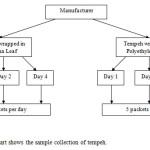 |
Figure 1: Flowchart shows the sample collection of tempeh. |
Measurement of total phenolic content
The appraisal of total phenolic content was done using Folin-Ciocalteu assay.12 Tempeh extract (200 μl) was added with 1.5 ml of Folin-Ciocalteu reagent (0.2 N). The mixture was vortexed for 1 min and let to react for 5 min at room temperature. After that, the reaction mixture was added with 1.5 ml of sodium bicarbonate solution (0.6 M) before subjected to vortexing. After allowed to react for 90 min, the absorbance was taken at 725 nm using a UV-visible spectrophotometer (UV-200-RS, LW Scientific, Georgia, USA). Gallic acid (0.04-0.15 mg/ml) was used to generate a standard calibration curve. Results were reported as mg gallic acid equivalent (GAE)/g of tempeh extract.
Determination of daidzein and genistein
The HPLC analysis was performed using an Agilent 1100 HPLC system consisted quaternary pump, autosampler and diode array detector (DAD). Daidzein and genistein were separated using extra-dense bonding (XDB) C18 column (250 mm x 4.6 mm x 5 μm; Agilent, Walbronn, Germany). The mobile phase was 0.1% (v/v) acetic acid and methanol (52:48). The flowrate of the mobile phase was set at 1.0 ml/min. The temperature of the stationary phase was set at 30°C and the sample was injected at 20 μl. The detection was performed at 254 nm. The analysis was done in triplicate. The chromatographic peaks of daidzein and genistein were analysed according to the retention time of the external standards. Standard calibration curves of daidzein (y = 34.773x + 72.63, R2=0.9978) and genistein (y = 76.24x + 125.08, R2=0.9978) were prepared at the range of 6.25-50 and 6.25-100 µg/ml, respectively. The results were reported as mg/g of tempeh extract.
Measurement of DPPH radical scavenging activity
The DPPH radical scavenging activity of the tempeh extract was determined as described by Othman et al.13. Two hundred microlitres of tempeh extract (20-200 mg/ml) was added with 1 ml of DPPH solution (500 μM). The mixture was left to react in dark for 30 min. Following 30 min, the absorbance was read at 517 nm using a spectrophotometer. The analysis was done in triplicates and 70% ethanol was used as a blank. A control was prepared by replacing the sample with 200 μl of 70% ethanol. The percentage of DPPH scavenged was calculated according to the equation as follows;

A graph on scavenging effect against concentration was plotted and the EC50 of each tempeh extract was calculated. EC50 is the concentration of tempeh extract needed to inhibit 50% of DPPH radical.
Measurement of β-carotene bleaching activity
The antioxidant activity of tempeh extract was determined by the method modified from Velioglu et al.12 In this assay, butylated hydroxytoluene (BHT) was used for comparison. One millilitre of β-carotene (0.2 mg/ml in chloroform) was aliquoted into a container which was pre-added with linoleic acid (0.02 ml) and Tween 20 (0.2 ml). Immediately, the mixture was dried at 40°C for 10 min under a vacuum evaporator (Büchi® Rotavapor, Flawil, Switzerland). After evaporation, 100 ml of ultra-pure water was added into the mixture and the mixture was shaken to produce emulsions. Then, the emulsion (5 ml) was aliquoted into each test tube with 0.2 ml of tempeh extract (100 mg/ml) or BHT (200 µg/ml). The mixture was vortexed for a minute before incubating in the water bath at 45°C for 2 h. The absorbance at 470 nm was recorded at every 20 min interval for 120 min. All samples were determined in triplicates and 70% ethanol was used as blank. For control, the tempeh extract was replaced with 70% ethanol. Degradation rate (DR) of β-carotene was counted using the formula as shown;
DR sample or standard = ln (A0/At) x 1/t
ln = natural log; A0 = absorbance (470nm) at time 0; At = absorbance (470nm) at 20, 40, 60, 80, 100 or 120 min; t = time of absorbance reading. As for the antioxidant activity (AA), it was expressed as the percentage of inhibition comparative to the control. The following equation was used to calculate the antioxidant activity of the tempeh extract or standard;

Results and Discussion
Total phenolic content
In this study, the unfermented tempeh extract (day 0) had a lower (p < 0.05) total phenolic content (1.74 GAE mg/g of tempeh extract) as compared to their fermented counterparts (2.93 to 6.97 GAE in mg/g of tempeh extract) (Figure 2). The current findings were in agreement with previous study that also showed an increment in total phenolic content of soybean after fermentation. Juan and Chou reported that fermentation of black soybean at the solid state can improve the total phenolic content of the black soybean.14 Another study had reported that isoflavone aglycones of Thai fermented soybean were higher than the unfermented one, but isoflavone aglycones were decreased at a longer fermentation period.15 Hence, fermentation may cause the liberation of aglycones from its complexes via hydrolysis but this may expose the compounds to degradation when the time is prolonged.16 Isoflavones are the derivatives of flavonoids which is one of the subgroups of polyphenols. Thus, total phenolic content of tempeh extract was higher than the initial unfermented tempeh extract.
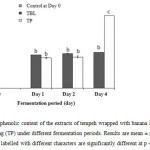 |
Figure 2: Total phenolic content of the extracts of tempeh wrapped with banana leaf (TBL) and polyethylene bag (TP) under different fermentation periods. Results are mean ± standard deviation. Data labelled with different characters are significantly different at p < 0.05. |
The increments of total phenolic content were not significant (p > 0.05) in both TBL and TP on day 1 and day 2. On day 4 of fermentation, there was a rapid increment (p < 0.05) of total phenolic content in TP. Total phenolic content in TP on day 4 was about 6.97 GAE in mg/g of tempeh extract which was almost double of the total phenolic content of TBL on day 4, about 3.46 GAE in mg/g of tempeh extract. A study reported that black bean koji fermented by Aspergillus awamori also contained a higher total phenolic content as the fermentation period increased and reached its highest total phenolic content on day 4 of fermentation, but total phenolic content declined in the following days.17 However, the extension of fermentation period was not done in the current study as it is not suitable for human consumption.
To the best of our knowledge, limited studies have been done on the effect of different wrapping materials on total phenolic content of fermented soybean as well as their isoflavones compounds. Current results suggested that tempeh wrapped in polyethylene bag could enhance the polyphenolic components to release through the fermentation process. Cho et al., suggested that isoflavones, flavanols and phenolic acids in the Korean whole soybean fermented food ‘cheonggukjang’ were augmented with the arising of enzymes activities like β-glycosidase and esterase, and later contributed to the remarkable increased in total phenolic content of the fermented soybean.16 Additionally, aglycones are easy to be absorbed by enterocytes in human small intestine as compared to their glycosides.18 Despite the supposing increase in its nutritional values, tempeh wrapped in polyethylene bag was not in favour to be edible as it reached day 4 of fermentation. According to Liu, tempeh is commonly taken not more than 2 days after the fermentation started due to the off flavour, slimy texture, growth of contaminated bacteria and ammoniacal odour.19 However, it will be useful for the food industry if the fermentation of the tempeh is purposely conducted for their bioactive components to produce functional products.
Daidzein and genistein contents
Separation and quantification of daidzein and genistein in the tempeh extracts were further done. Daidzein content was increased in both type of samples after fermentation, but TBL reached its highest daidzein content on day 2 (1.34 mg/g of tempeh extract) and started to decrease on day 4 (Figure 3). However, TP gave a consistent increment in daidzein content as the fermentation period increased and reached the highest daidzein content on day 4. The highest daidzein content was obtained in TBL on day 2 as compared to TP on day 4. However, the difference of daidzein content between TBL and TP was not significant (p > 0.05) on day 1
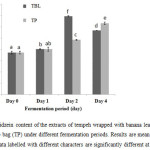 |
Figure 3: Daidzein content of the extracts of tempeh wrapped with banana leaf (TBL) and polyethylene bag (TP) under different fermentation periods. Results are mean ± standard deviation. Data labelled with different characters are significantly different at p < 0.05. Click here to View figure |
A similar trend was observed in genistein content. It was found to be increased gradually from day 0 to day 1 for TBL and reached the highest level on day 2, which was 0.94 mg/g of tempeh extract (Figure 4). However, TBL on day 4 showed a slightly lower (p < 0.05) genistein content as compared to day 2. TP exhibited the highest genistein content on day 4, which is 96 h after the fermentation. Hence, the banana leaf may facilitate the production of daidzein and genistein using a shorter period, within 2 days. Chaiyasut et al. demonstrated that daidzein content and genistein content in Thai fermented soybean were increased as the fermentation time increased.15 In addition, Kwon et al. reported that when the fermentation period increase, the bound polyphenols 6-O-malonylglucoside content was declined and there was a concomitant increase in non-conjugated aglycones (genistein and daidzein).6 Hence, a more complete hydrolysis of isoflavone glycosides may occur if the fermentation period is prolonged.
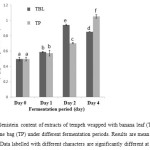 |
Figure 4: Genistein content of extracts of tempeh wrapped with banana leaf (TBL) and polyethylene bag (TP) under different fermentation periods. Results are mean ± standard deviation. Data labelled with different characters are significantly different at p < 0.05. |
However, the levels of daidzein and genistein of TBL were dropped (p < 0.05) on day 4, thus TBL is not suitable to be used for a longer fermentation period in order to prevent the degradation of these valuable isoflavones. Generally, tempeh will be consumed by the consumers within day 1 or day 2 after purchased from the market. As similar to total phenolic content, TP gave a higher level of daidzein and genistein on day 4 but it may be inedible. A study showed that when the fermented soybean was kept for a longer period at room temperature, a reduction of isoflavone content was found, including their aglycones and glucosides.20 Even though polyethylene bag is an easier way and considered as a modern material for wrapping the tempeh, it is less effective in providing an increment of isoflavone aglycones content via fermentation at the common period of local consumption as compared to those wrapped with banana leaf.
2,2-diphenyl-2-picrylhydrazyl (DPPH) radical scavenging activity
The principle behind DPPH radical scavenging assay is to evaluate the reducing capacity of the sample tested.21 The scavenging activities of the tempeh extracts of TBL and TP on DPPH radicals were increased as the fermentation period prolonged (Figure 5a). Besides that, DPPH radical scavenging activity was responded in the dose-dependent manner. The EC50 values were calculated and shown in Figure 5b. A lower EC50 value indicates a better ability of the sample extract to scavenge DPPH radicals owing to least sample extract is needed to counteract with 50% of the DPPH radical. The lowest EC50 value was found in TP on day 4 which is 67.33 mg/ml. It indicates that as the fermentation period increased, the EC50 of TP was significantly (p < 0.05) decreased. Current results were agreed by Juan and Chou who also found that the EC50 value of DPPH radical scavenging activity obtained from fermented soybean was lower than the unfermented soybean.14 It may be related to the release of the more active aglycones throughout the fermentation process and later increase the scavenging activities of the tempeh extract. This result was similar to Hu et al., that fermented black soybean natto inoculated with Bacillus natto had a remarkably stronger DPPH free radical scavenging activity than the unfermented one.3 At the same time, Hu and colleagues also demonstrated the radical scavenging activity was increased linearly with the duration of fermentation.3
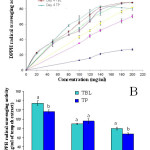 |
Figure 5: DPPH radical scavenging activity (A) and EC50 of DPPH radical scavenging activity (B) of the extracts of tempeh wrapped with banana leaf (TBL) and polyethylene bag (TP) under different fermentation periods. Results are mean ± standard deviation. Values at the similar fermentation day with different characters are significantly different at p < 0.05. Click here to View figure |
As previously mentioned the fermentation increased the antioxidant components in both TBL and TP and hence contributed to the increment of DPPH radical scavenging activity. Correlation analysis revealed that there was a very significant positive relationship (r = 0.969, p < 0.05) between total phenolic content of TP and DPPH radical scavenging activity. However, TBL showed a weak relationship to DPPH radical scavenging activity (r = 0.299, p < 0.05). Total phenolic content was reported to be able to influence the DPPH radical-scavenging activity.16 Both Folin-Ciocalteu assay for total phenolic content and DPPH radical scavenging assay are electron transfer based assays.21 Hence, due to the similarity in the redox reaction of these assays, an excellent correlation between total phenolic content measured with Folin-Ciocalteu reagent and DPPH radical scavenging activity was seen in many studies.21 Polyphenols are the reactive compounds that are susceptible to free radicals.5,22 Thus, the increment of total phenolic content can contribute to the increase radical scavenging activities. On the other hand, a significant but weaker correlation between total phenolic content of TBL and DPPH radical scavenging activity was observed. This may be due to other compounds that also contributed to the antioxidant activities. Phytochemicals such as tocopherols (vitamin E) and soyasapogenol B (aglycone of soya saponins) are the good examples of DPPH scavenger that can also be found in soybean products.2
β-Carotene linoleate bleaching
Due to the complexity of phytochemicals, antioxidant activity of a dietary extract is unable to be assessed with only one single method, as there is no single method that can clearly reflect the total antioxidant activity of a tested sample. Beta-carotene-linoleate bleaching assay is a hydrogen atom transfer based assay.21 This assay involves the generation of hydroperoxides as free radicals from linoleic acid when incubated at 45°C. The colour of β-carotene (orange) will then undergo a rapid degradation without the protection of antioxidant.
Antioxidant activity of the tempeh extracts is shown in Figure 6. For TBL, no significant (p > 0.05) difference was found in antioxidant activity as the fermentation period prolonged but an ascending trend was observed. A similar trend was observed in TP. However, there was a significant (p < 0.05) increased in antioxidant activity from TP on day 1 of fermentation (28%) to day 2 of fermentation (51%). The highest antioxidant activity was obtained from TP on day 2 of fermentation. The similar finding was reported by Chaiyasut et al. that antioxidant activity of fermented soybean is increased during fermentation15. Kwak et al. studied on antioxidant activity in chung-kook-jong, the fermented soybeans, also showed a better antioxidant activity than the unfermented steamed one, which is probably attributed to its improved contents of aglycone isoflavone and malonylglycoside isoflavone after the fermentation.23 There was a positive correlation (r = 0.272, p < 0.05) between total phenolic content and antioxidant activity in TBL as well as total phenolic content and antioxidant activity in TP (r = 0.635, p < 0.05). Hence, polyphenolic compounds especially daidzein and genistein in the tempeh could somehow contribute to the prevention of linoleate oxidation.
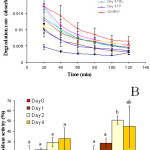 |
Figure 6: Beta-carotene degradation rate (A) and antioxidant activity (B) of the extracts of tempeh wrapped with banana leaf (TBL) and polyethylene bag (TP) after different fermentation periods measured using β-carotene-linoleate bleaching method. |
Conclusion
This study showed that total phenolic content, daidzein, genistein and antioxidant capacity were increased in both tempeh wrapped in banana leaf and polyethylene bag as the fermentation progressed. The antioxidant properties between tempeh wrapped in banana leaf and polyethylene bag were significantly increased on day 2 or after. However, the banana leaf was found to be a better material due to it provided a higher antioxidant content of tempeh on day 2 which is the best consumption period of this soybean product. Fermentation of tempeh using a polyethylene material can be considered by the industry if the production of soybean-related products is mainly targeting for higher bioactive components. It is interesting for future research to develop a better wrapping material or method for tempeh production which can provide sufficient fermentation in a shorter period without compromising its nutritional values.
Acknowledgements
The authors would like to thank the laboratory facilities and technical support provided by International Medical University and Universiti Putra Malaysia.
References
- Babu P. D., Bhakyaraj R., Vidyalakshmi R. A Low Cost Nutritious Food “Tempeh”- A Review. World J Dairy Food Sci. 2009;4(1):22-27.
- Hubert J., Berger M., Nepveu F., Paul F., Dayde J. Effects of Fermentation on the Phytochemical Composition and Antioxidant Properties of Soy Germ. Food Chem. 2008;109(4):709-721.
CrossRef - Hu Y., Ge C., Yuan W., Zhu R., Zhang W., Du L., Xue J. Characterization of Fermented Black Soybean Natto Inoculated with Bacillus natto during Fermentation. Journal of Sci Food Agric. 2010;90(7):1194-1202.
CrossRef - Lim J-Y., Kim J. J., Lee D. S., Kim, G. H., Shim J-Y., Lee I., Imm J-Y. Physicochemical Characteristics and Production of Whole Soymilk from Monascus Fermented Soybeans. Food Chem. 2010;20(1):266-280.
CrossRef - Moktan B., Saha J., Sarkar P. K. Antioxidant Activities of Soybean as Affected by Bacillus-Fermentation to Kinema. Food Res Int. 2008;41(6):586-593.
CrossRef - Kwon D. Y., Daily J. W., Kim H. J., Park S. Antidiabetic Effects of Fermented Soybean Products on Type 2 Diabetes. Nutr Res. 2010;30(1):1-13.
CrossRef - Park E., Shin J. I., Park O. J., Kang M. H. Soy Isoflavone Supplementation Alleviates Oxidative Stress and Improves Systolic Blood Pressure in Male Spontaneously Hypertensive Rats. J Nutri Sci Vitaminol. 2005;51(4):254-259.
CrossRef - Scalbert A., Manach C., Morand C., Rémésy C., Jiménez L. Dietary Polyphenols and The Prevention of Diseases. Crit Rev Food Sci Nutr. 2005;45(4):287-306.
CrossRef - Esaki H., Onozaki H., Kawakishi S., Osawa T. New Antioxidant Isolated from Tempeh. J Agric Food Chem. 1996;44(3):696-700.
CrossRef - Lee J. H., Renita M., Fioritto R. J., St. Maritin S.K., Schwartz S.J., Vodovotz Y. Isoflavone Characterization and Antioxidant Activity of Ohio Soybeans. J Agric Food Chem. 2004;52(9):2647-51.
CrossRef - Monje M. C., Berger M., Farines V., Reybier K., Verger A., Daydé J., Théodorou V., Nepveu F. Antioxidant Capacity of Cotyledons and Germs of Soybean in Relation to Their Isoflavone Content. Food Technol Biotechnol. 2006;44(4):493-8.
- Velioglu Y. S., Mazza G., Gao L., Oomah B. D. Antioxidant Activity and Total Phenolics in Selected Fruits, Vegetables and Grain Products. J Agric Food Chem. 1998;46(10):4113-4117.
CrossRef - Othman A., Ismail A., Ghani N.A., Adenan I. Antioxidant Capacity and Phenolic Content of Cocoa Beans. Food Chem. 2007;100(4):1523-1530.
CrossRef - Juan Y., Chou, C-C. Enhancement of Antioxidant Activity, Total Phenolic and Total Flavonoid Content of Black Soybeans by Solid State Fermentation with Bacillus subtilis BCRC 14715. Food Microbiol. 2010;27(5):586-591.
CrossRef - Chaiyasut C., Kumar T., Tipduangta P., Rungseevijitprapa W. Isoflavone Content and Antioxidant Activity of Thai Fermented Soybean and Its Capsule Formulation. Afr J Biotechnol. 2010;9(26):4120-4126.
- Cho K. M., Hong S. Y., Math R. K., Lee J. H., Kambiranda D. M., Kim J. M., Asraful Islam S. M., Yun M. G., Cho J. J., Lim W. J., Yun, H. D. Biotransformation of Phenolics (Isoflavones, Flavanols and Phenolic Acids) during the Fermentation of Cheonggukjang by Bacillus pumilus HY1. Food Chem. 2009;114(2):413–419.
CrossRef - Lee I-H., Hung Y-H., Chou C-C. Total Phenolic and Anthocyanin Contents as well as Antioxidant Activity of Black Bean Koji Fermented by Aspergillus awamori under Different Culture Conditions. Food Chem. 2007;104(3):936-942.
CrossRef - Manach C., Scalbert A., Morand C., Rémésy C., Jiménez L. Polyphenols: Food Sources and Bioavailability. Am J Clin Nutr. 2004;79(5):727-747.
CrossRef - Liu K. S. Soybeans: Chemistry, Technology and Utilization. New York: Chapman and Hall; 1997.
CrossRef - Kim J. K., Kim S. H., Hahn S. J., Chung M. Changing Soybean Isoflavone Composition and Concentrations under Two Different Storage Conditions Over Three Years. Food Res Int. 2005;38(4):435-444.
CrossRef - Huang D., Ou B., Prior R.L. The Chemistry behind Antioxidant Capacity Assays. J Agric Food Chem. 2005;53(6):1841-1856.
CrossRef - Gao Z. H., Huang K. X., Yang X. L., Xu, H. B. Free Radical Scavenging and Antioxidant Activities of Flavonoids Extracted from the Radix of Scutellaria baicalensis Georgi. Biochim Biophys Acta. 1999;1472(3):643-650.
CrossRef - Kwak C. S., Lee M. S., Park S. C. Higher Antioxidant Properties of Chungkookjang, A Fermented Soybean Paste, may be due to Increased Aglycone and Malonylglycoside Isoflavone during Fermentation. Nutr Res. 2007;27(11):719-727.
CrossRef

This work is licensed under a Creative Commons Attribution 4.0 International License.






